Gold Nano-Island Platforms for Localized Surface Plasmon Resonance Sensing: A Short Review
Abstract
1. Introduction
2. Solid-State Dewetting of Thin Metal Films: Principle and Driving Force
2.1. Nano-Island Platforms from Thin Metal Films
2.1.1. Plasmonic Sensing Based on Thermally Generated Nano-Islands
2.2. Nano-Island Platforms from Nanoparticle Films
2.3. Integrated Biosensors for Medical and Clinical Diagnostics
3. Conclusions and Outlook
Author Contributions
Funding
Acknowledgments
Conflicts of Interest
References
- Ruffino, F.; Grimaldi, M.G. Self-organized patterned arrays of Au and Ag nanoparticles by thickness-dependent dewetting of template-confined films. J. Mater. Sci. 2014, 49, 5714–5729. [Google Scholar] [CrossRef]
- Thompson, C.V. Solid-State Dewetting of Thin Films. Annu. Rev. Mater. Res. 2012, 42, 399–434. [Google Scholar] [CrossRef]
- Abbott, W.M.; Corbett, S.; Cunningham, G.; Petford-Long, A.; Zhang, S.; Donegan, J.F.; McCloskey, D. Solid State Dewetting of Thin Plasmonic Films under Focused Cw-Laser Irradiation. Acta Mater. 2018, 145, 210–219. [Google Scholar] [CrossRef]
- Wong, H.; Voorhees, P.; Miksis, M.; Davis, S. Periodic mass shedding of a retracting solid film step. Acta Mater. 2000, 48, 1719–1728. [Google Scholar] [CrossRef]
- Qiu, G.; Gai, Z.; Tao, Y.; Schmitt, J.; Kullak-Ublick, G.A.; Wang, J. Dual-Functional Plasmonic Photothermal Biosensors for Highly Accurate Severe Acute Respiratory Syndrome Coronavirus 2 Detection. ACS Nano 2020, 14, 5268–5277. [Google Scholar] [CrossRef]
- Srolovitz, D.J.; Goldiner, M.G. The Thermodynamics and Kinetics of film agglomeration. JOM 1995, 47, 31–36. [Google Scholar] [CrossRef]
- De Gennes, P.G. Wetting: Statics and dynamics. Rev. Mod. Phys. 1985, 57, 827–863. [Google Scholar] [CrossRef]
- Baumann, N.; Mutoro, E.; Janek, J. Porous model type electrodes by induced dewetting of thin Pt films on YSZ substrates. Solid State Ion. 2010, 181, 7–15. [Google Scholar] [CrossRef]
- Setina Batic, B.; Verbovsek, T.; Setina, J. Decomposition of thin Au films on flat and structured Si substrate by annealing. Vacuum 2017, 138, 134–138. [Google Scholar] [CrossRef]
- Łapiński, M.; Kozioł, R.; Cymann, A.; Sadowski, W.; Koscielska, B. Substrate Dependence in the Formation of Au Nanoislands for Plasmonic Platform Application. Plasmonics 2020, 15, 101–107. [Google Scholar] [CrossRef]
- Trice, J.; Thomas, D.; Favazza, C.; Sureshkumar, R.; Kalyanaraman, R. Pulsed-laser-induced dewetting in nanoscopic metal films: Theory and experiments. Phys. Rev. B 2007, 75, 235439. [Google Scholar] [CrossRef]
- Nishijima, Y.; Hashimoto, Y.; Seniutinas, G.; Rosa, L.; Juodkazis, S. Engineering gold alloys for plasmonics. Appl. Phys. A 2014, 117, 641–645. [Google Scholar] [CrossRef]
- Tesler, A.B.; Maoz, B.M.; Feldman, Y.; Vaskevich, A.; Rubinstein, I. Solid-State Thermal Dewetting of Just-Percolated Gold Films Evaporated on Glass: Development of the Morphology and Optical Properties. J. Phys. Chem. C 2013, 117, 11337–11346. [Google Scholar] [CrossRef]
- Thompson, C.V.; Carel, R. Texture development in polycrystalline thin films. Mater. Sci. Eng. B 1995, 32, 211–219. [Google Scholar] [CrossRef]
- Wei, H.L.; Huang, H.; Woo, C.H.; Zheng, R.K.; Wen, G.H.; Zhang, X.X. Development of <110> texture in copper thin films. Appl. Phys. Lett. 2002, 80, 2290–2292. [Google Scholar] [CrossRef]
- Bhalla, N.; Jain, A.; Lee, Y.; Shen, A.Q.; Lee, D. Dewetting metal nanofilms—Effect of substrate on refractive index sensitivity of nanoplasmonic gold. Nanomaterials 2019, 9, 1530. [Google Scholar] [CrossRef]
- Marin, B.C.; Ramírez, J.; Root, S.E.; Aklile, E.; Lipomi, D.J. Metallic nanoislands on graphene, a metamaterial for chemical, mechanical, optical, and biological applications. Nanoscale Horiz. 2017, 2, 311–318. [Google Scholar] [CrossRef]
- Marin, B.C.; Liu, J.; Aklile, E.; Urbina, A.D.; Chiang, A.S.-C.; Lawrence, N.; Chen, S.; Lipomi, D.J. SERS-Enhanced Piezoplasmonic Graphene Composite for Biological and Structural Strain Mapping. Nanoscale 2017, 9, 1292–1298. [Google Scholar] [CrossRef]
- Chen, B.; Mokume, M.; Liu, C.; Hayashi, K. Structure and localized surface plasmon tuning of sputtered Au nano-islands through thermal annealing. Vacuum 2014, 110, 94–101. [Google Scholar] [CrossRef]
- Doron-Mor, I.; Barkay, Z.; Filip-Granit, N.; Vaskevich, A.; Rubinstein, I. Ultrathin Gold Island Films on Silanized Glass. Morphology and Optical Properties. Chem. Mater. 2004, 16, 3476–3483. [Google Scholar] [CrossRef]
- Kalyuzhny, G.; Vaskevich, A.; Schneeweiss, M.; Rubinstein, I. Transmission surface-plasmon resonance (T-SPR) measurements for monitoring adsorption on ultrathin gold island films. Chem. Eur. J. 2002, 8, 3850. [Google Scholar]
- Colas, F.; Barchiesi, D.; Kessentini, S.; Toury, T.; de la Chapelle, M.L. Comparison of adhesion layers of gold on silicate glasses for SERS detection. J. Opt. 2015, 17, 114010. [Google Scholar]
- Ruach-Nir, I.; Bendikov, T.A.; Doron-Mor, I.; Barkay, Z.; Vaskevich, A.; Rubinstein, I. Silica-Stabilized Gold Island Films for Transmission Localized Surface Plasmon Sensing. J. Am. Chem. Soc. 2007, 129, 84–92. [Google Scholar] [CrossRef] [PubMed]
- Szunerits, S.; Praig, V.G.; Manesse, M.; Boukherroub, R. Gold island films on indium tin oxide for localized surface plasmon sensing. Nanotechnology 2008, 19, 195712. [Google Scholar] [CrossRef]
- Moody, N.R.; Adams, D.P.; Volinsky, A.A.; Kriese, M.D.; Gerberich, W.W. Annealing Effects on Interfacial Fracture of Gold-Chromium Films in Hybrid Microcircuits. MRS Proc. 1999, 586, 195. [Google Scholar] [CrossRef]
- Habteyes, T.G.; Dhuey, S.; Wood, E.; Gargas, D.; Cabrini, S.; Schuck, P.J.; Alivisatos, A.P.; Leone, S.R. Metallic adhesion layer induced plasmon damping and molecular linker as a nondamping alternative. ACS Nano 2012, 6, 5702–5709. [Google Scholar] [CrossRef]
- Kang, M.; Ahn, M.-S.; Lee, Y.; Jeong, K.-H. Bioplasmonic Alloyed Nanoislands using Dewetting of Bilayer Thin Films. ACS Appl. Mater. Interfaces 2017, 9, 37154–37159. [Google Scholar] [CrossRef]
- Karakouz, T.; Tesler, A.B.; Bendikov, T.A.; Vaskevich, A.; Rubinstein, I. Highly stable localized plasmon transducers obtained by thermal embedding of gold island films on glass. Adv. Mater. 2008, 20, 3893–3899. [Google Scholar] [CrossRef]
- Goss, C.A.; Charych, D.; Majda, M. Application of (3-mercaptopropyl) trimethoxysilane as a molecular adhesive in the fabrication of vapor-deposited gold electrodes on glass substrates. Anal. Chem. 1991, 63, 85–88. [Google Scholar] [CrossRef]
- Cantale, V.; Simeone, F.C.; Gambari, R.; Rampi, M.A. Gold nano-islands on FTO as plasmonic nanostructures for biosensors. Sens. Actuators B Chem. 2011, 152, 206–213. [Google Scholar] [CrossRef]
- Ghorbanpour, M.; Falamaki, C. A novel method for the production of highly adherent Au layers on glass substrates used in surface plasmon resonance analysis: Substitution of Cr or Ti intermediate layers with Ag layer followed by an optimal annealing treatment. J. Nanostruct. Chem. 2013, 3, 66. [Google Scholar] [CrossRef]
- De Almeida, J.M.M.M.; Vasconcelos, H.; Jorge, P.A.S.; Coelho, L. Plasmonic optical fiber sensor based on double step growth of gold nano-islands. Sensors 2018, 18, 1267. [Google Scholar] [CrossRef] [PubMed]
- Kwak, J.; Lee, W.; Kim, J.B.; Bae, S.I.; Jeong, K.H. Fiber-optic plasmonic probe with nanogap-rich Au nanoislands for on-site surface-enhanced Raman spectroscopy using repeated solid-state dewetting. J. Biomed. Opt. 2019, 24, 1–6. [Google Scholar] [CrossRef] [PubMed]
- Kedem, O.; Tesler, A.B.; Vaskevich, A.; Rubinstein, I. Sensitivity and Optimization of Localized Surface Plasmon Resonance Transducers. ACS Nano 2011, 5, 748–760. [Google Scholar] [CrossRef] [PubMed]
- Doron-Mor, I.; Cohen, H.; Barkay, Z.; Shanzer, A.; Vaskevich, A.; Rubinstein, I. Sensitivity of transmission surface plasmon resonance (T-SPR) spectroscopy: Self-assembled multilayers on evaporated gold island films. Chem. Eur. J. 2005, 11, 5555–5562. [Google Scholar] [CrossRef] [PubMed]
- Bonyár, A.; Csarnovics, I.; Veres, M.; Himics, L.; Csik, A.; Kámán, J.; Balázs, L.; Kökényesi, S. Investigation of the performance of thermally generated gold nanoislands for LSPR and SERS applications. Sens. Actuators B 2018, 255, 433–439. [Google Scholar] [CrossRef]
- Longobucco, G.; Fasano, G.; Zharnikov, M.; Bergamini, L.; Corni, S.; Rampi, M.A. High stability and sensitivity of gold nano-islands for localized surface plasmon spectroscopy: Role of solvent viscosity and morphology. Sens. Actuators B Chem. 2014, 191, 356–363. [Google Scholar] [CrossRef]
- Choi, J.-H.; Lee, J.-H.; Son, J.; Choi, J.-W. Noble Metal-Assisted Surface Plasmon Resonance Immunosensors. Sensors 2020, 20, 1003. [Google Scholar] [CrossRef]
- Lopez, G.A.; Estevez, M.; Soler, M.; Lechuga, L.M. Recent advances in nanoplasmonic biosensors: Applications and lab-on-a-chip integration. Nanophotonics 2016, 6, 123–136. [Google Scholar] [CrossRef]
- Jia, K.; Bijeon, J.-L.; Adam, P.-M.; Ionescu, R.E. Large Scale Fabrication of Gold Nano-Structured Substrates Via High Temperature Annealing and Their Direct Use for the LSPR Detection of Atrazine. Plasmonics 2013, 8, 143–151. [Google Scholar] [CrossRef]
- Ozhikandathil, J.; Packirisamy, M. Simulation and implementation of a morphology-tuned gold nano-islands integrated plasmonic sensor. Sensors 2014, 14, 10497–10513. [Google Scholar] [CrossRef] [PubMed]
- Bathini, S.; Raju, D.; Badilescu, S.; Kumar, A.; Ouellette, R.J.; Ghosh, A.; Packirisamy, M. Nano-Bio Interactions of Extracellular Vesicles with Gold Nanoislands for Early Cancer Diagnosis. Research 2018, 2018, 3917986. [Google Scholar] [CrossRef]
- Ozhikandathil, J.; Badilescu, S.; Packirisamy, M. Gold nanoisland structures integrated in a lab-on-a-chip for plasmonic detection of bovine growth hormone. J. Biomed. Opt. 2012, 17, 077001. [Google Scholar] [CrossRef]
- Ozhikandathil, J.; Badilescu, S.; Packirisamy, M. Technical note: A portable on-chip assay system for absorbance and plasmonic detection of protein hormone in milk. J. Dairy Sci. 2015, 98, 4384–4391. [Google Scholar] [CrossRef] [PubMed]
- Badilescu, S.; Packirisamy, M. Microfluidics-Nano-Integration for Synthesis and Sensing. Polymers 2012, 4, 1278–1310. [Google Scholar] [CrossRef]
- Ozhikandathil, J.; Badilescu, S.; Packirisamy, M. Silver nano-islands for plasmonic detection of proteins. In Proceedings of the World Congress on New Technologies (NewTech 2015), Barcelona, Spain, 15–17 July 2015. Paper No. 378. [Google Scholar]
- Prevo, B.G.; Fuller, J.C.; Velev, O.D. Rapid Deposition of Gold Nanoparticle Films with Controlled Thickness and Structure by Convective Assembly. Chem. Mater. 2005, 17, 28–35. [Google Scholar] [CrossRef]
- Duraichelvan, R.; Srinivas, B.; Badilescu, S.; Ouellette, R.; Ghosh, A.; Packirisamy, M. Exosomes detection by a label-free localized surface plasmonic resonance method. ECS Trans. 2016, 75, 11–17. [Google Scholar] [CrossRef]
- Ghosh, A.; Davey, M.; Chute, I.C.; Griffiths, S.G.; Lewis, S.; Chacko, S.; Crapoulet, N.; Fournier, S.; Joy, A.; Caissie, M.C.; et al. Rapid Isolation of Extracellular Vesicles from Cell Culture and Biological Fluids Using a Synthetic Peptide with Specific Affinity for Heat Shock Proteins. PLoS ONE 2014, 9, e110443. [Google Scholar] [CrossRef]
- Srinivas, B.; Duraichelvan, R.; Badilescu, S.; Packirisamy, M. Microfluidic Plasmonic Bio-Sensing of Exosomes by Using a Gold Nano-Island Platform. Int. J. Biomed. Biol. Eng. 2018, 12, 226–229. [Google Scholar]
- Feng, T.; Ding, L.; Chen, L.; Di, J. Deposition of gold nanoparticles upon bare and indium tin oxide film coated glass based on annealing process. J. Exp. Nanosci. 2019, 14, 13–22. [Google Scholar] [CrossRef]
- Tokel, O.; Inci, F.; Demirci, U. Advances in plasmonic technologies for point of care applications. Chem. Rev. 2014, 114, 5728–5752. [Google Scholar] [CrossRef] [PubMed]
- Yu, T.; Wei, Q. Plasmonic molecular assays: Recent advances and applications for mobile health. Nano Res. 2018, 11, 5439–5473. [Google Scholar] [CrossRef] [PubMed]
- Badilescu, S.; Packirisamy, M. Plasmonic biosensors on a chip for Point-of-Care applications. Electrochem. Soc. Interface 2019, 28, 65–69. [Google Scholar] [CrossRef]
- Raju, D.; Bathini, S.; Badilescu, S.; Ouellette, R.J.; Ghosh, A.; Packirisamy, M. LSPR detection of extracellular vesicles using a silver-PDMS nano-composite platform suitable for sensor networks. Enterp. Inf. Systems. 2020, 14, 532–541. [Google Scholar] [CrossRef]
- Guo, C.F.; Sun, T.; Cao, F.; Liu, Q.; Ren, Z. Metallic nanostructures for light trapping in energy-harvesting devices. Light Sci. Appl. 2014, 3, e161. [Google Scholar] [CrossRef]
- Ryu, J.; Kim, H.S.; Hahn, H.T.; Lashmore, D. Carbon nanotubes with platinum nano-islands as glucose biofuel cell electrodes. Biosens. Bioelectron. 2010, 25, 1603–1608. [Google Scholar] [CrossRef]
- Do, M.T.; Tong, Q.C.; Lidiak, A.; Luong, M.H.; Ledoux-Rak, I.; Lai, N.D. Nano-patterning of gold thin film by thermal annealing combined with laser interference techniques. Appl. Phys. A 2016, 122, 360. [Google Scholar] [CrossRef]
- Gerislioglu, B.; Dong, L.; Ahmadivand, A.; Hu, H.; Nordlander, P.; Halas, N.J. Monolithic Metal Dimer-on-Film Structure: New Plasmonic Properties Introduced by the Underlying Metal. Nano Lett. 2020, 20, 2087–2093. [Google Scholar] [CrossRef]
- Gerislioglu, B.; Bakan, G.; Ahuja, R.; Adam, J.; Mishra, Y.K.; Ahmadivand, A. The Role of Ge2Sb2Te5 in Enhancing the Performance of Functional Plasmonic Devices. Mater. Today Phys. 2020, 12, 100178. [Google Scholar] [CrossRef]
Sample Availability: Samples of the nanoparticle films are available from the authors. |
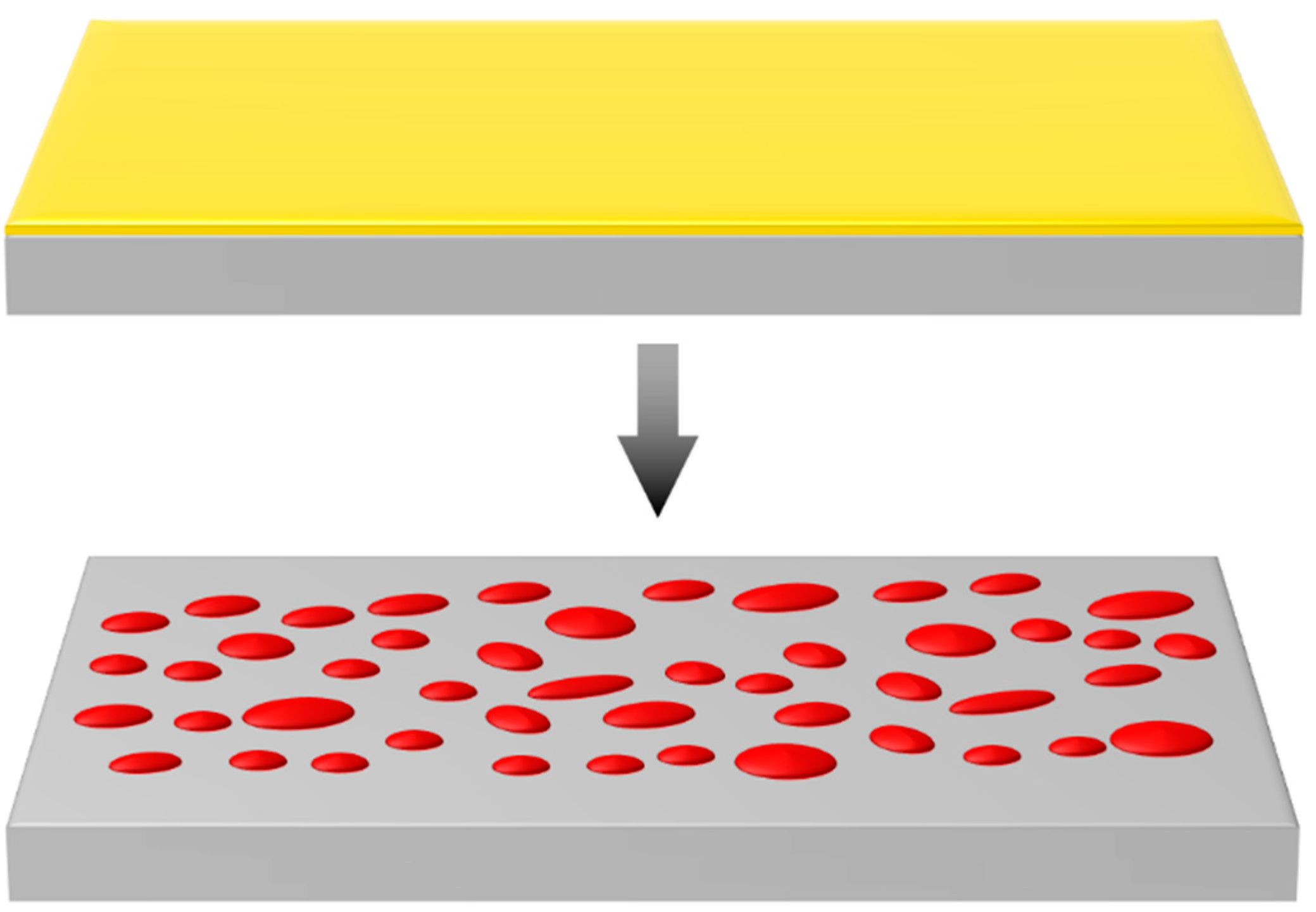
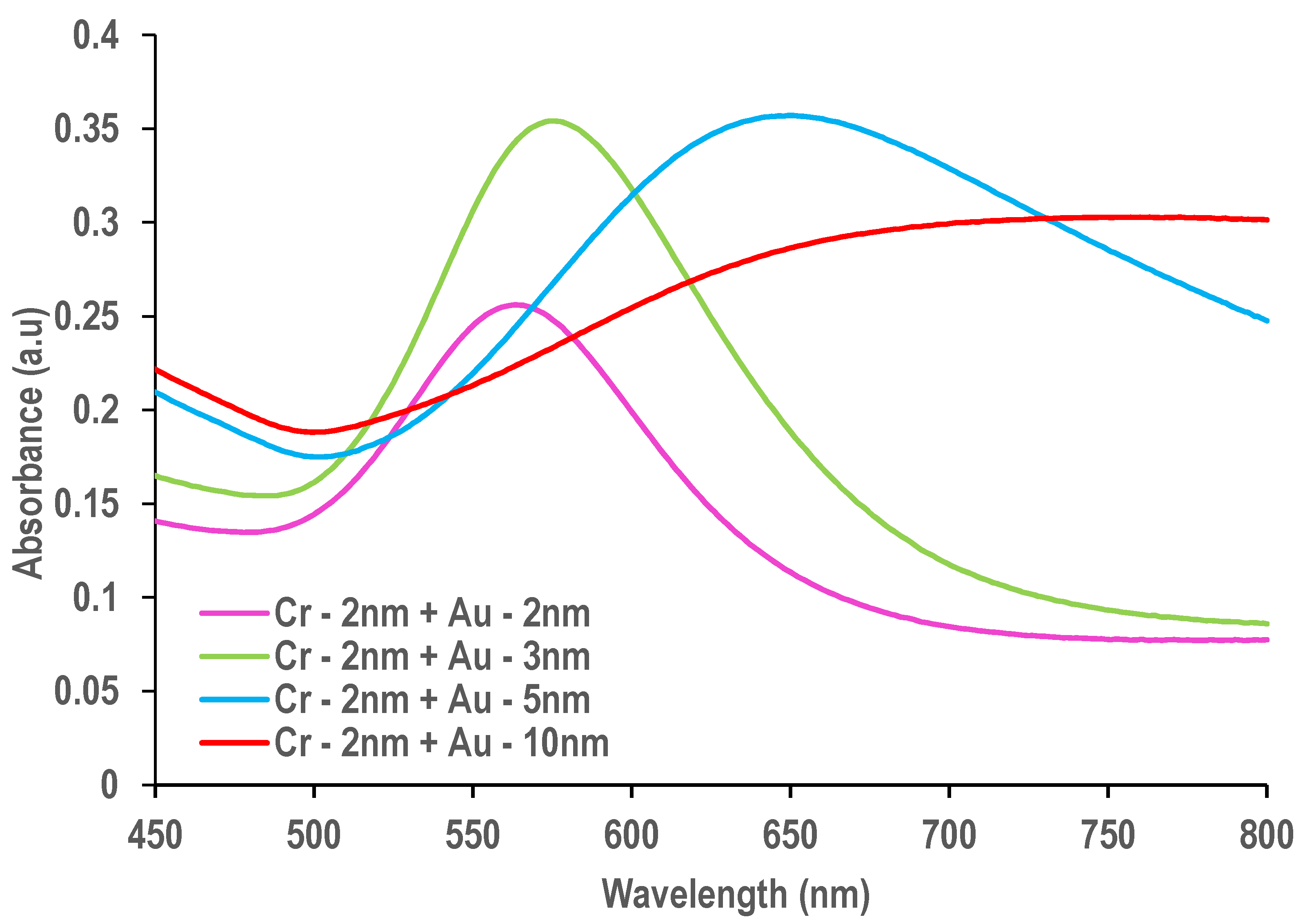
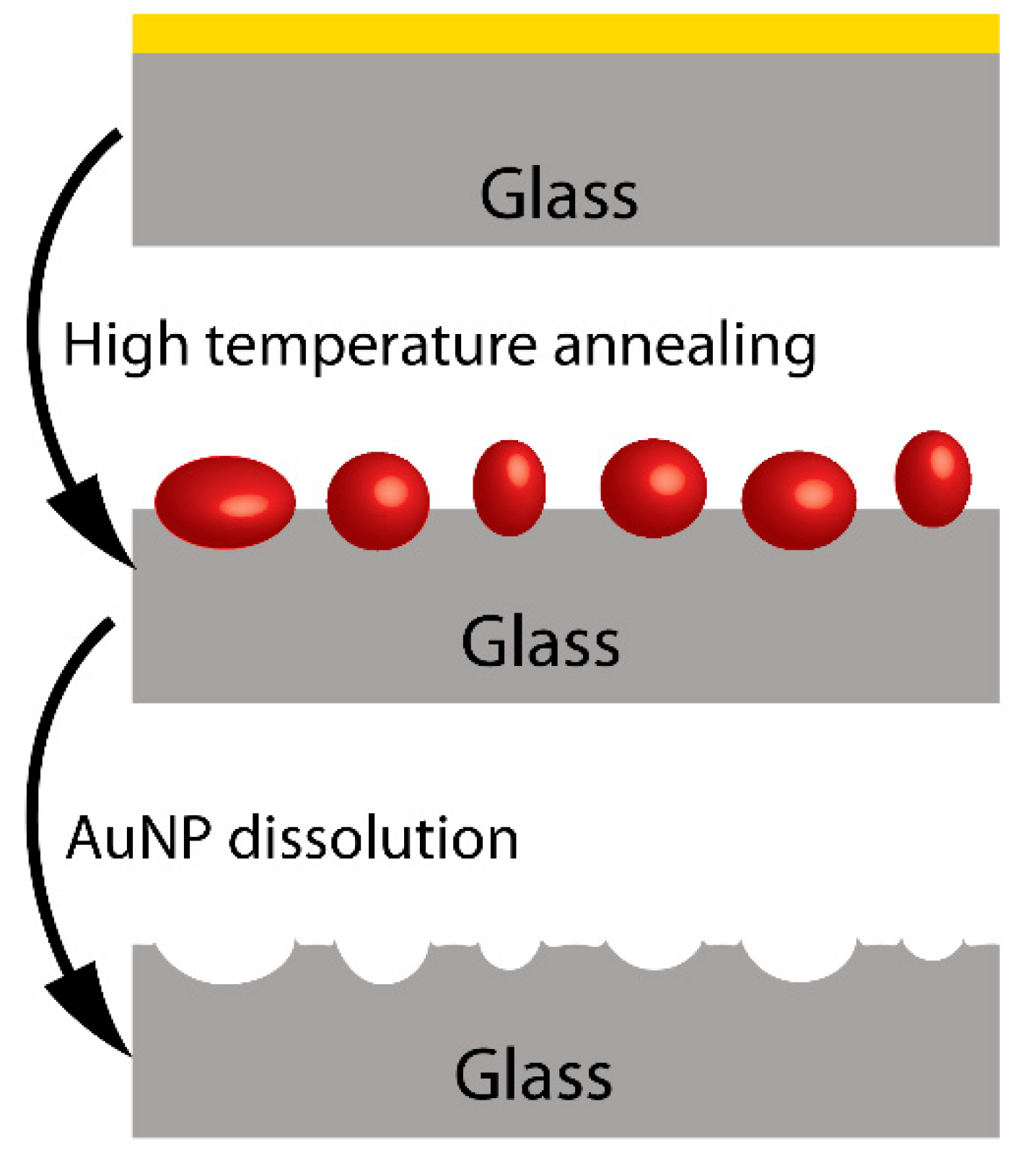
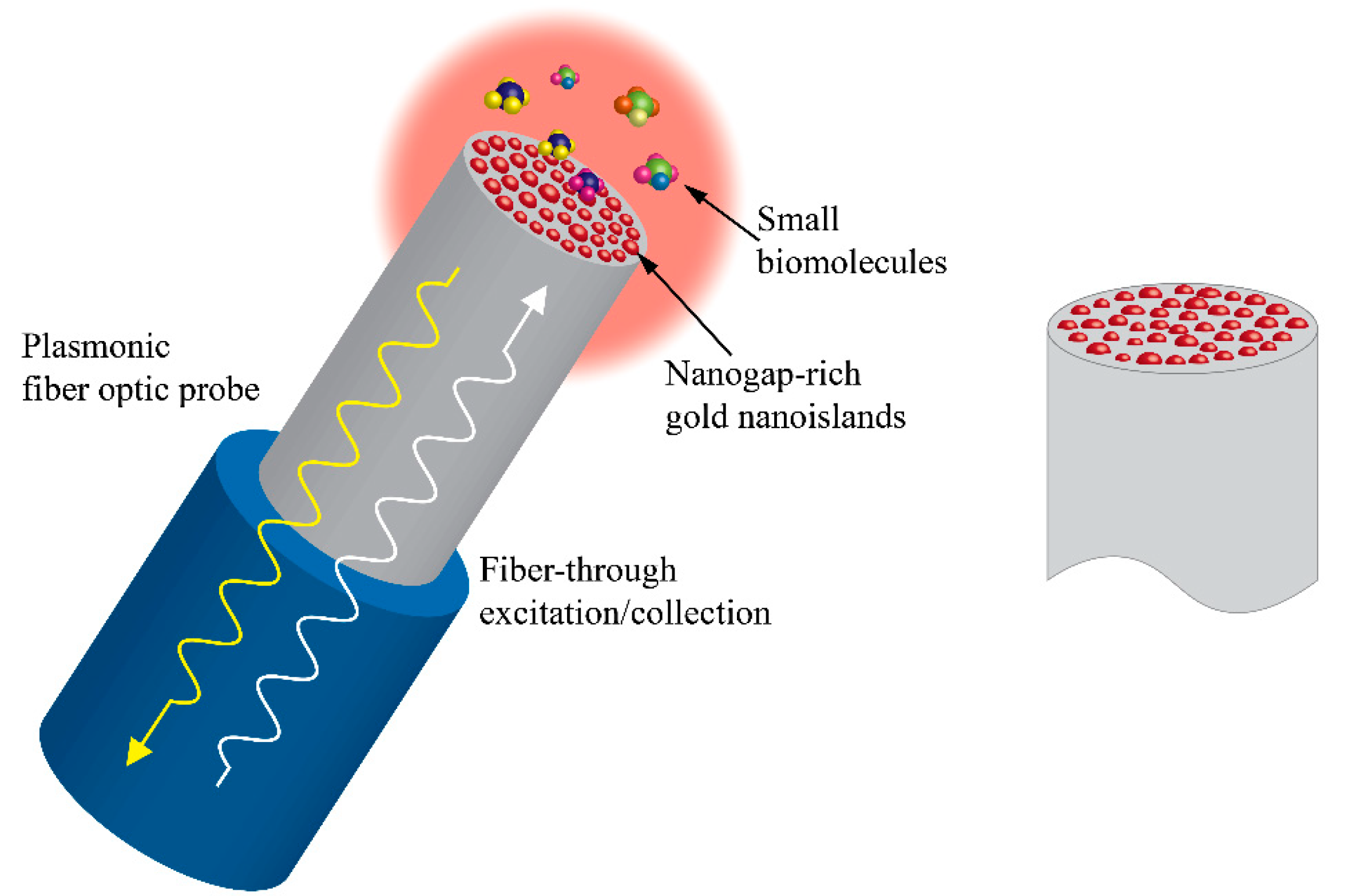
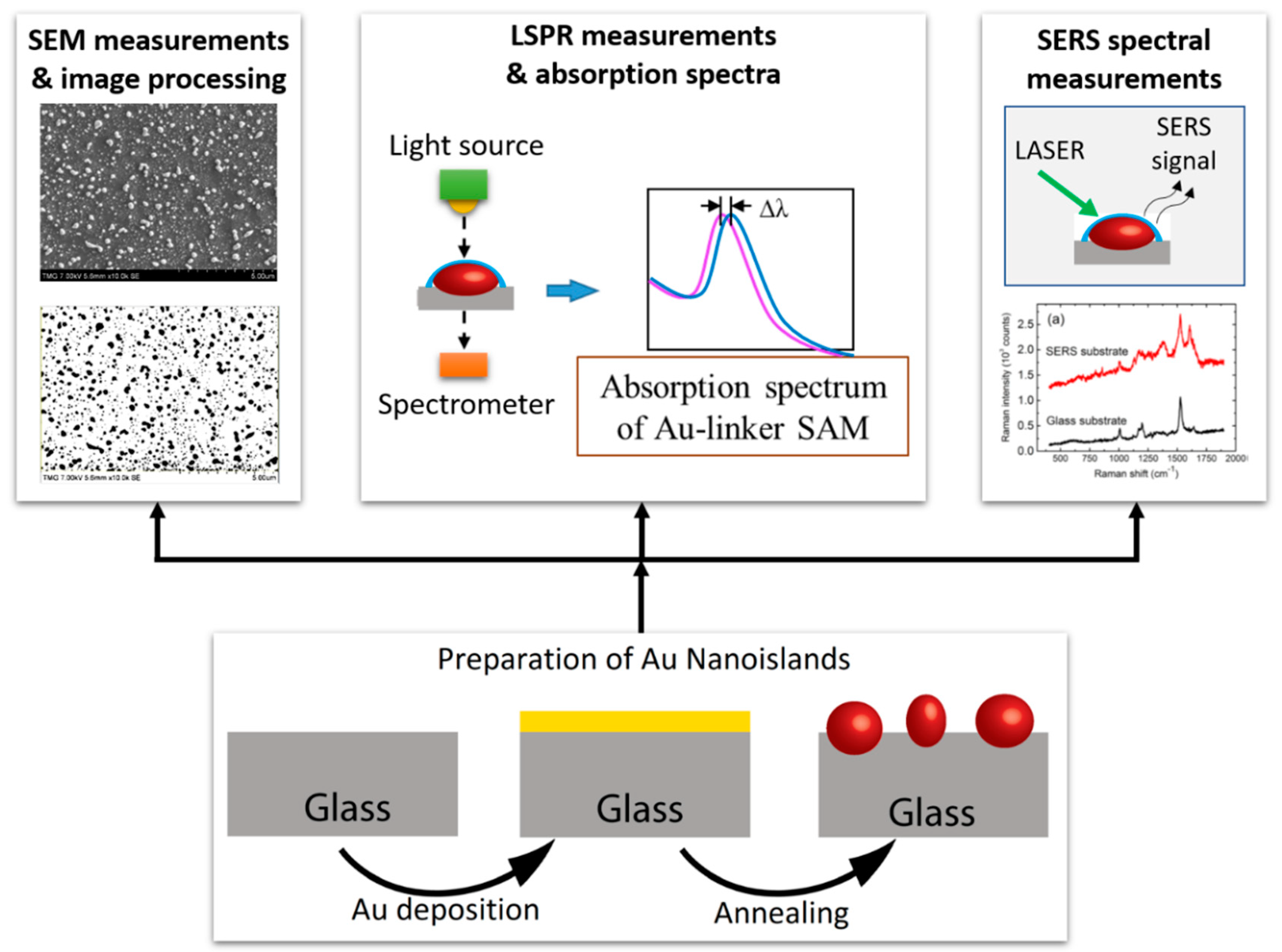
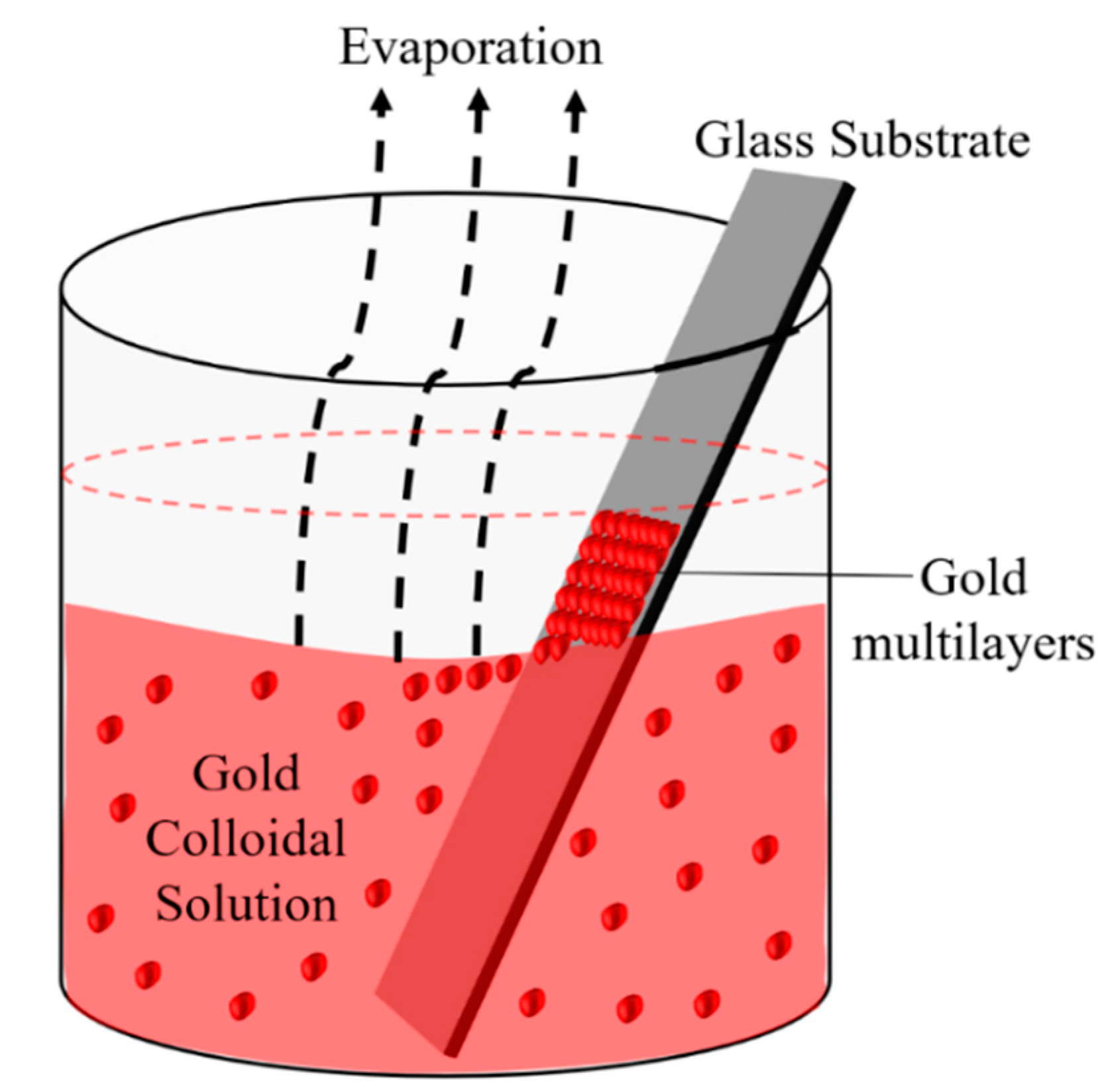

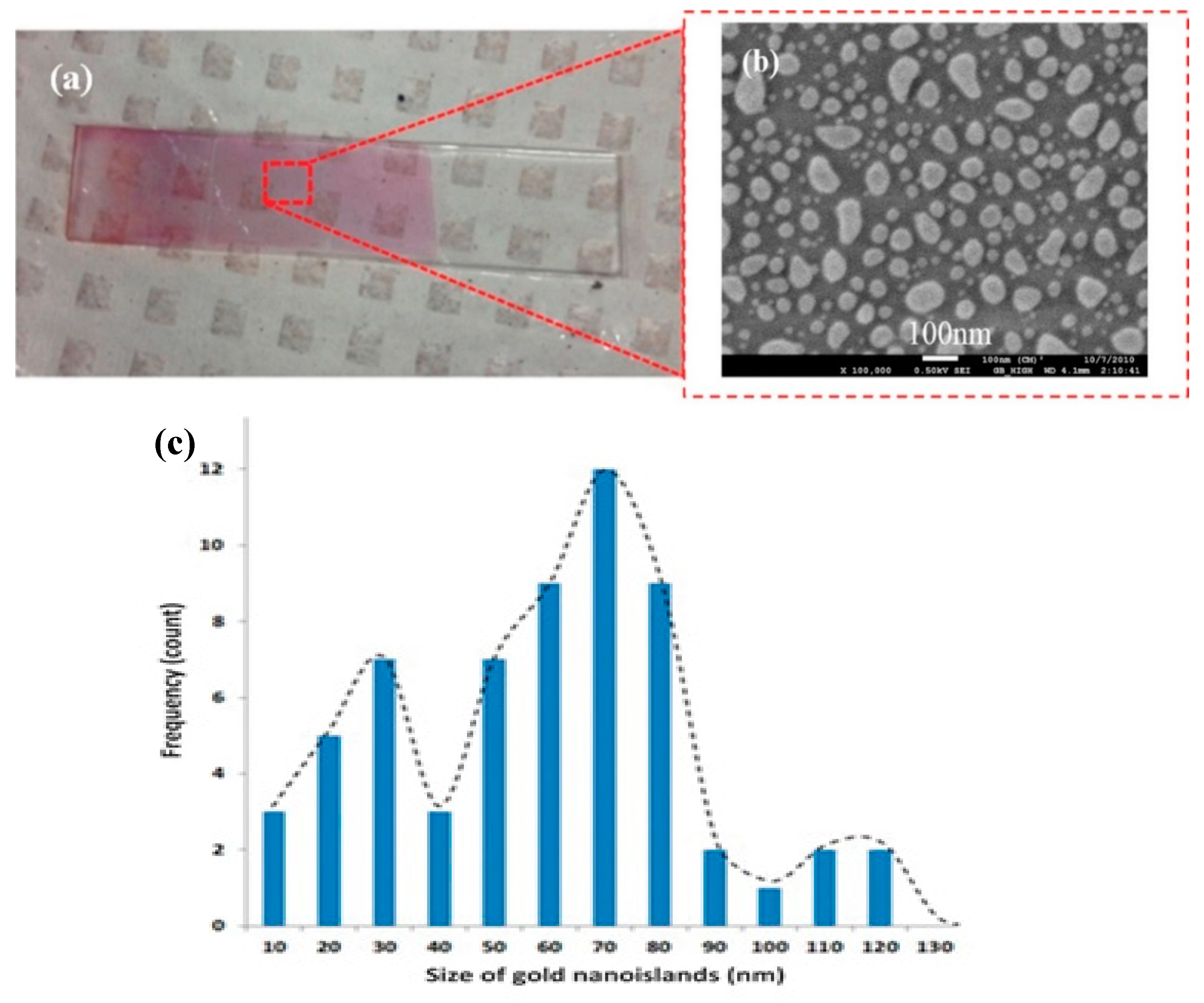
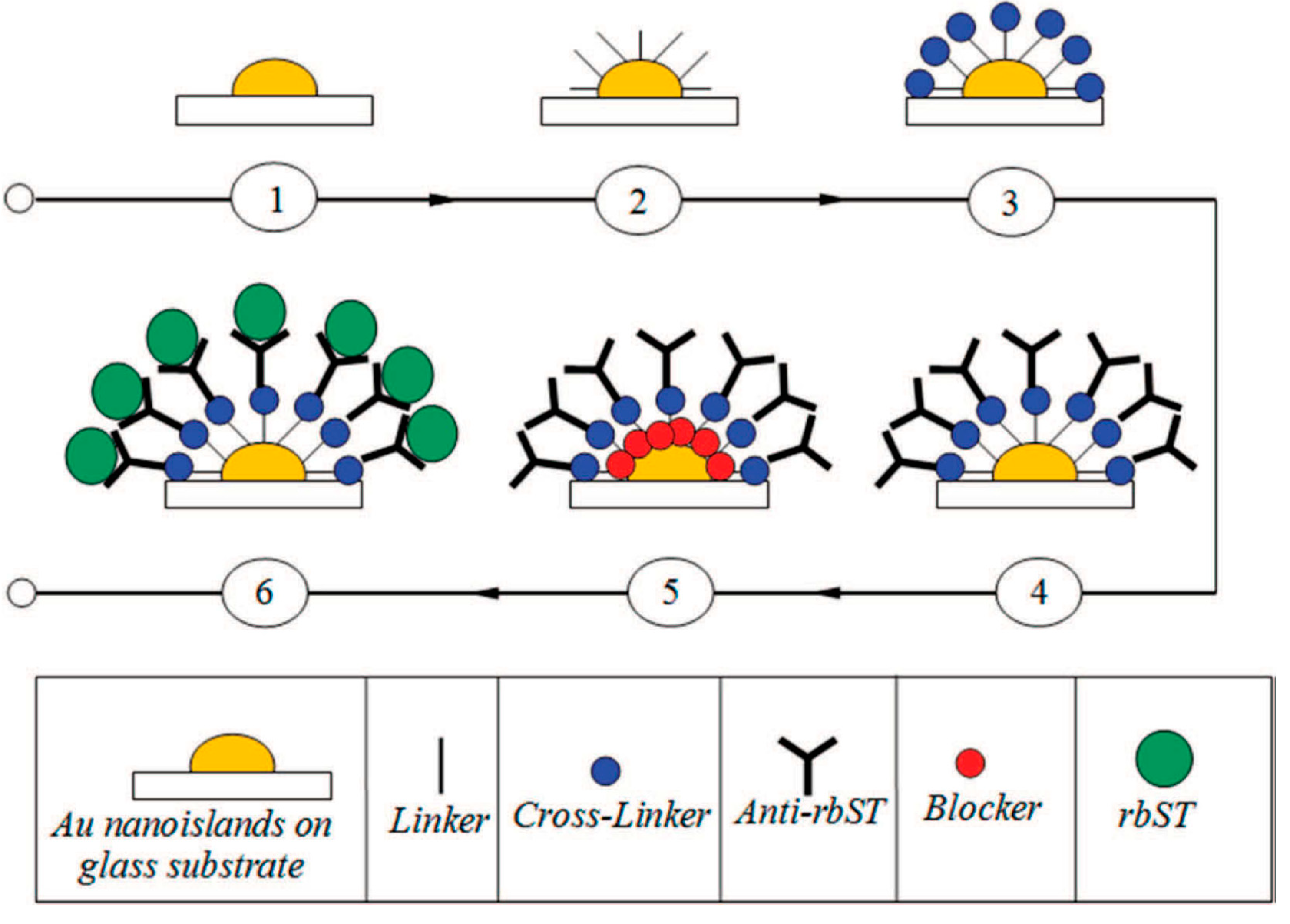
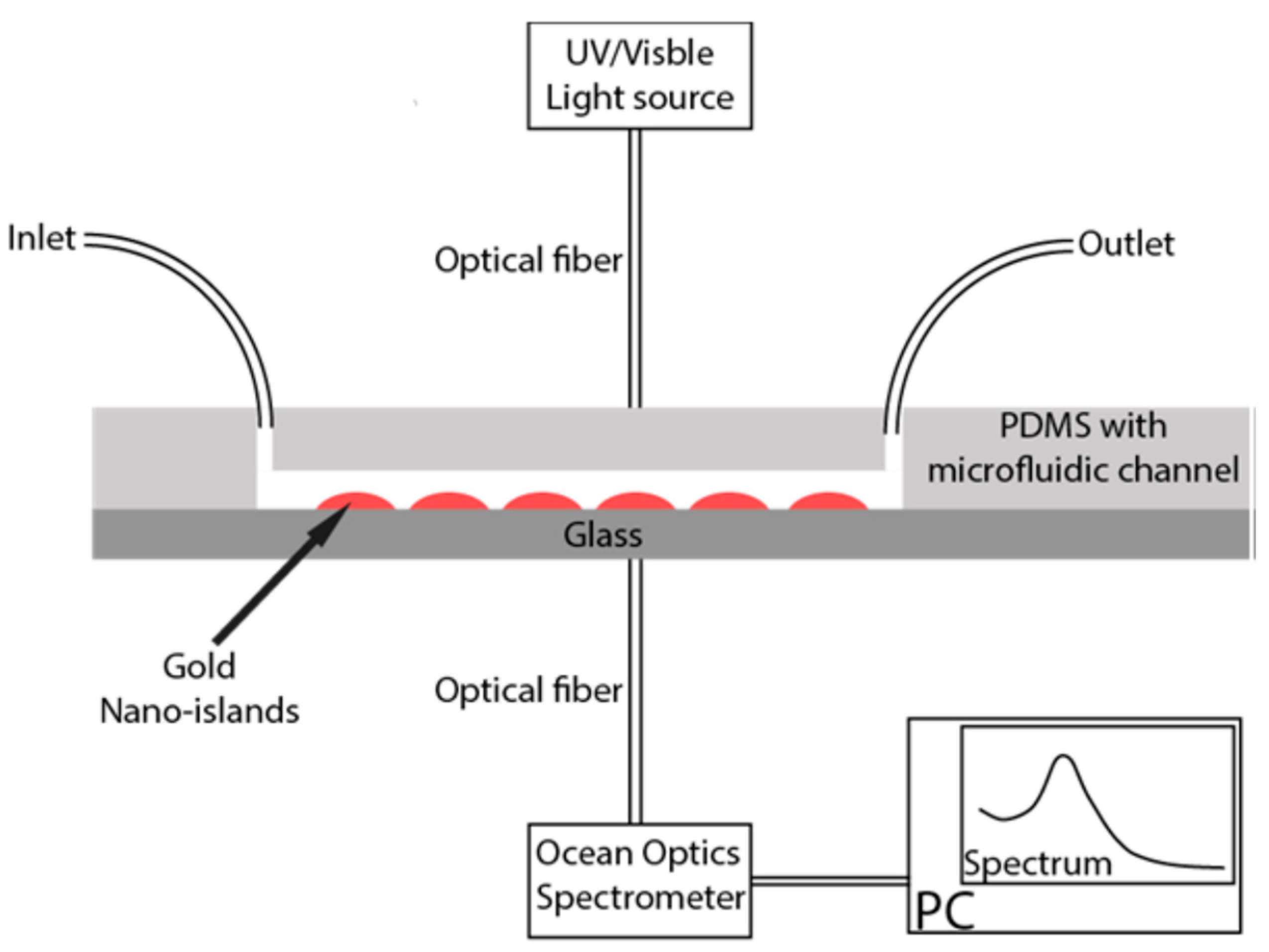
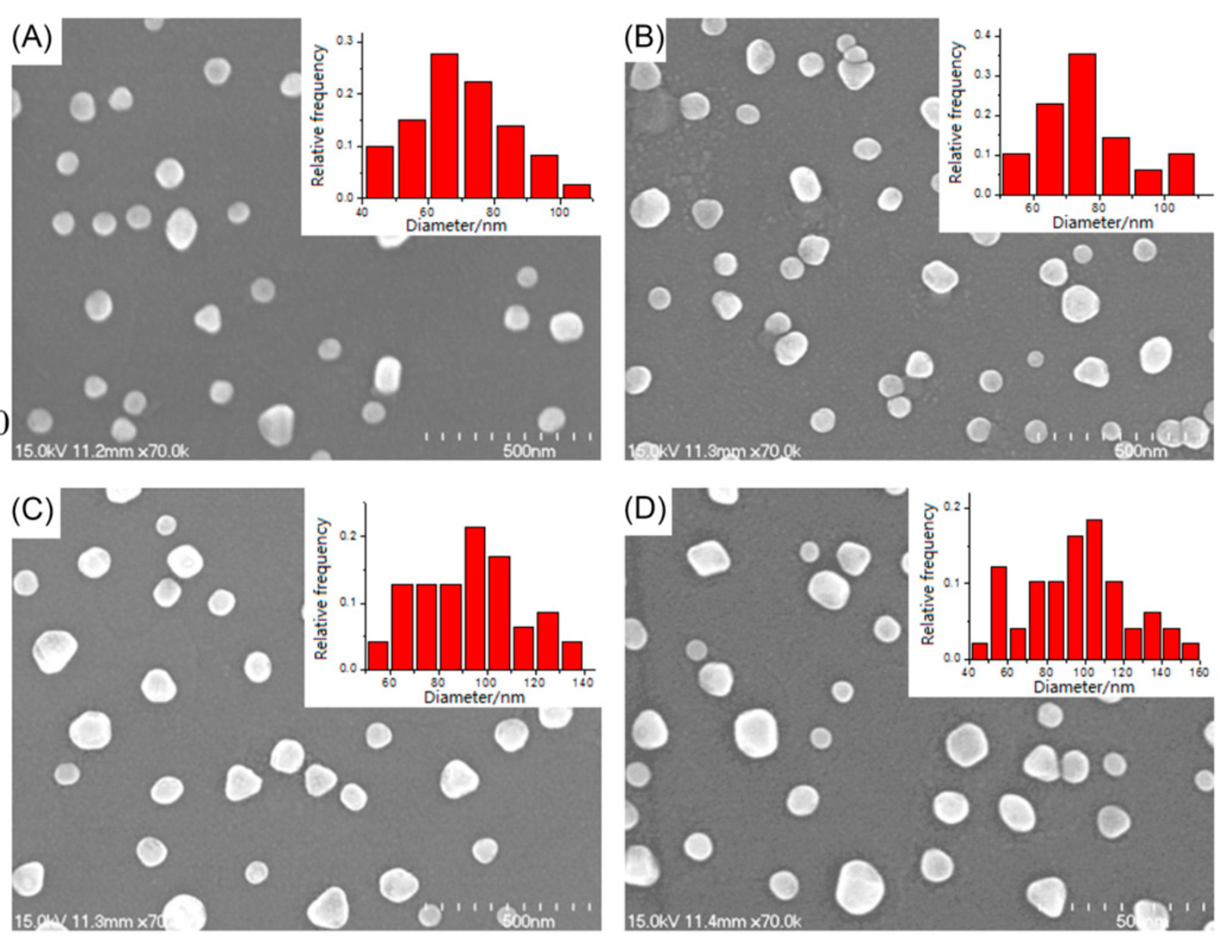
© 2020 by the authors. Licensee MDPI, Basel, Switzerland. This article is an open access article distributed under the terms and conditions of the Creative Commons Attribution (CC BY) license (http://creativecommons.org/licenses/by/4.0/).
Share and Cite
Badilescu, S.; Raju, D.; Bathini, S.; Packirisamy, M. Gold Nano-Island Platforms for Localized Surface Plasmon Resonance Sensing: A Short Review. Molecules 2020, 25, 4661. https://doi.org/10.3390/molecules25204661
Badilescu S, Raju D, Bathini S, Packirisamy M. Gold Nano-Island Platforms for Localized Surface Plasmon Resonance Sensing: A Short Review. Molecules. 2020; 25(20):4661. https://doi.org/10.3390/molecules25204661
Chicago/Turabian StyleBadilescu, Simona, Duraichelvan Raju, Srinivas Bathini, and Muthukumaran Packirisamy. 2020. "Gold Nano-Island Platforms for Localized Surface Plasmon Resonance Sensing: A Short Review" Molecules 25, no. 20: 4661. https://doi.org/10.3390/molecules25204661
APA StyleBadilescu, S., Raju, D., Bathini, S., & Packirisamy, M. (2020). Gold Nano-Island Platforms for Localized Surface Plasmon Resonance Sensing: A Short Review. Molecules, 25(20), 4661. https://doi.org/10.3390/molecules25204661







